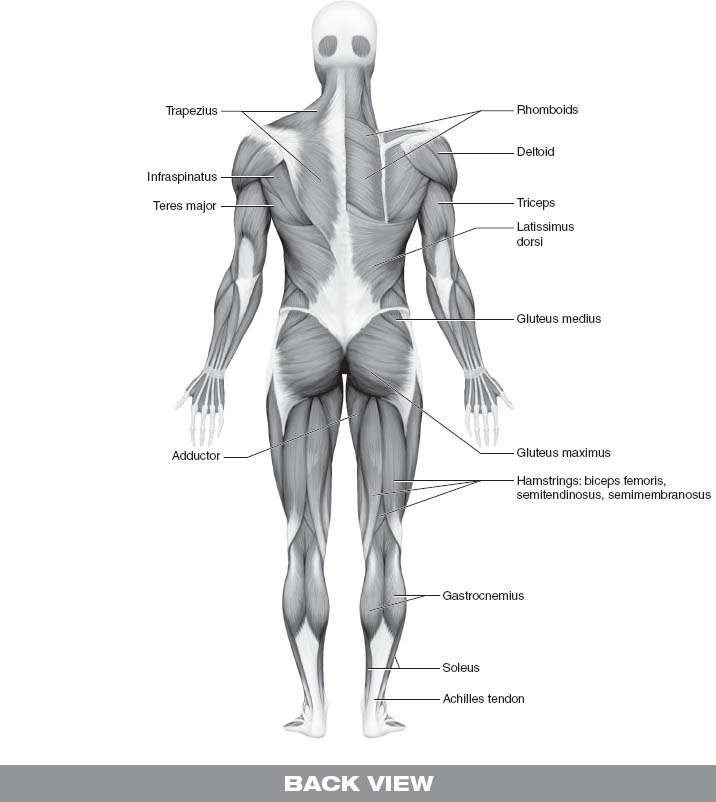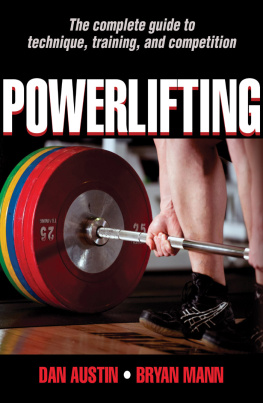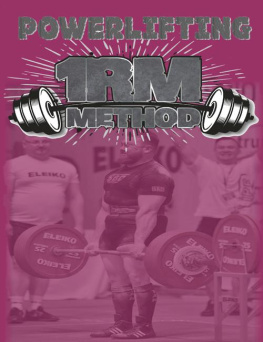

Library of Congress Cataloging-in-Publication Data
Austin, Dan, 1958-
Powerlifting / Dan Austin, Bryan Mann.
p. cm.
ISBN 978-0-7360-9464-1 (soft cover) -- ISBN 0-7360-9464-4 (soft cover)
1. Weight lifting. I. Mann, Bryan, 1979- II. Title.
GV546.3.A87 2012
796.41--dc23
2011049601
ISBN-10: 0-7360-9464-4 (print)
ISBN-13: 978-0-7360-9464-1 (print)
Copyright 2012 by Dan Austin and Bryan Mann
All rights reserved. Except for use in a review, the reproduction or utilization of this work in any form or by any electronic, mechanical, or other means, now known or hereafter invented, including xerography, photocopying, and recording, and in any information storage and retrieval system, is forbidden without the written permission of the publisher.
This publication is written and published to provide accurate and authoritative information relevant to the subject matter presented. It is published and sold with the understanding that the author and publisher are not engaged in rendering legal, medical, or other professional services by reason of their authorship or publication of this work. If medical or other expert assistance is required, the services of a competent professional person should be sought.
Acquisitions Editor: Justin Klug; Developmental Editor: Cynthia McEntire; Assistant Editor: Elizabeth Evans; Copyeditor: Joanna Hatzopoulos Portman; Permissions Manager: Martha Gullo; Graphic Designer: Bob Reuther; Graphic Artist: Francine Hamerski; Cover Designer: Keith Blomberg; Photographer (cover): Neil Bernstein; Photographer (interior): Neil Bernstein; Visual Production Assistant: Joyce Brumfield; Photo Production Manager: Jason Allen; Art Manager: Kelly Hendren; Associate Art Manager: Alan L. Wilborn; Illustrations: Human Kinetics; Printer: McNaughton & Gunn
We thank the University of Missouri in Columbia, Missouri, for assistance in providing the location for the shoot for this book.
Human Kinetics books are available at special discounts for bulk purchase. Special editions or book excerpts can also be created to specification. For details, contact the Special Sales Manager at Human Kinetics.
Printed in the United States of America 10 9 8 7 6 5 4 3 2 1
Human Kinetics
Website: www.HumanKinetics.com
United States: Human Kinetics
P.O. Box 5076
Champaign, IL 61825-5076
800-747-4457
e-mail:
Canada: Human Kinetics
475 Devonshire Road Unit 100
Windsor, ON N8Y 2L5
800-465-7301 (in Canada only)
e-mail:
Europe: Human Kinetics
107 Bradford Road
Stanningley
Leeds LS28 6AT, United Kingdom
+44 (0) 113 255 5665
e-mail:
Australia: Human Kinetics
57A Price Avenue
Lower Mitcham, South Australia 5062
08 8372 0999
e-mail:
New Zealand: Human Kinetics
P.O. Box 80
Torrens Park, South Australia 5062
0800 222 062
e-mail:
E5156
POWERLIFTING
Contents


T o understand how the body works in powerlifting, you first must understand some basic physiology. A basic understanding does not include topics such as sliding filament theory, the way the mitochondria work in the cell, or the role of fatty acids in metabolism for a long day at a meet. If those topics interest you, you can read books on exercise physiology or even take courses in human anatomy, physiology, and kinesiology. This chapter covers the level of physiology you need to know to become as strong as possible and perform optimally on competition day.
Motor Learning
Knowing how the body learns can help you understand how and why to use various techniques. For example, think about how an infant learns to walk. He observes people walking and he wants to try it too. After watching and analyzing others, he begins to try to walk. He slowly pulls himself up to a stand, he wobbles, and he falls down. Next he pulls himself up to a stand, he wobbles, and takes a step or two before falling down. Eventually after persistence, practice, and muscle development, he begins to walk naturally.
In their book Weightlifting: Fitness for All Sports (International Weightlifting Federation 1988), Tams Ajn and Lazar Baroga said that every movement, no matter how new it may seem, is based on previously learned movement patterns. So the more motor patterns you possess, the more movement patterns you can learn and the more quickly you can learn them. Consider two people who start squatting. Why does one struggle while the other excels? Because one person already possessed the necessary motor patterns and the other did not. The second person may be able to master the technique and excel at the squat but needs more time. A coach or trainer must demonstrate the movement several times so the struggling lifter understands it, then the lifter must get under the bar and do it himself. At first the movements feel funny to him, and he does all sorts of funny things as well, just as a baby does when trying to walk for the first time. The lifter may crash his knees together then do an impression of the worm break dance, but while standing with a weight on his back. He may perform something that looks like a good morning with bent legs. All along, he is attempting to put together movements that resemble the squat. The coachs job is to teach him to be aware of what hes doing wrong and how to fix it. Eventually he will have a squatlike movement down but will still need to refine his technique. Louie Simmons once said that a coach needs to educate each one of his lifters to the point at which the lifter is a coach. That way whenever youre doing a lift, youll have 10 coaches watching instead of one.
Next page















